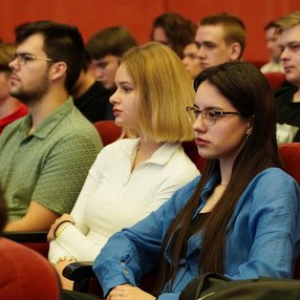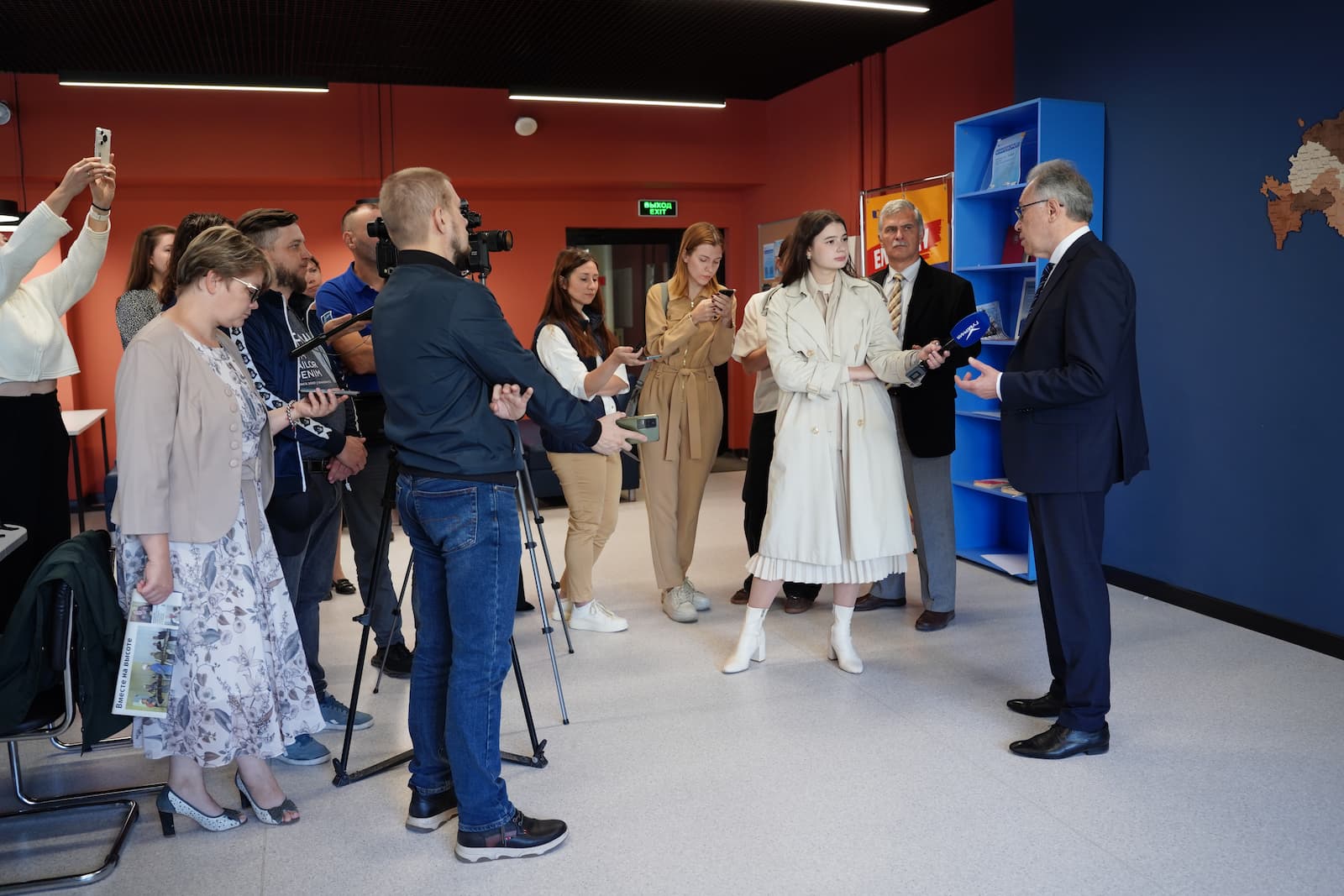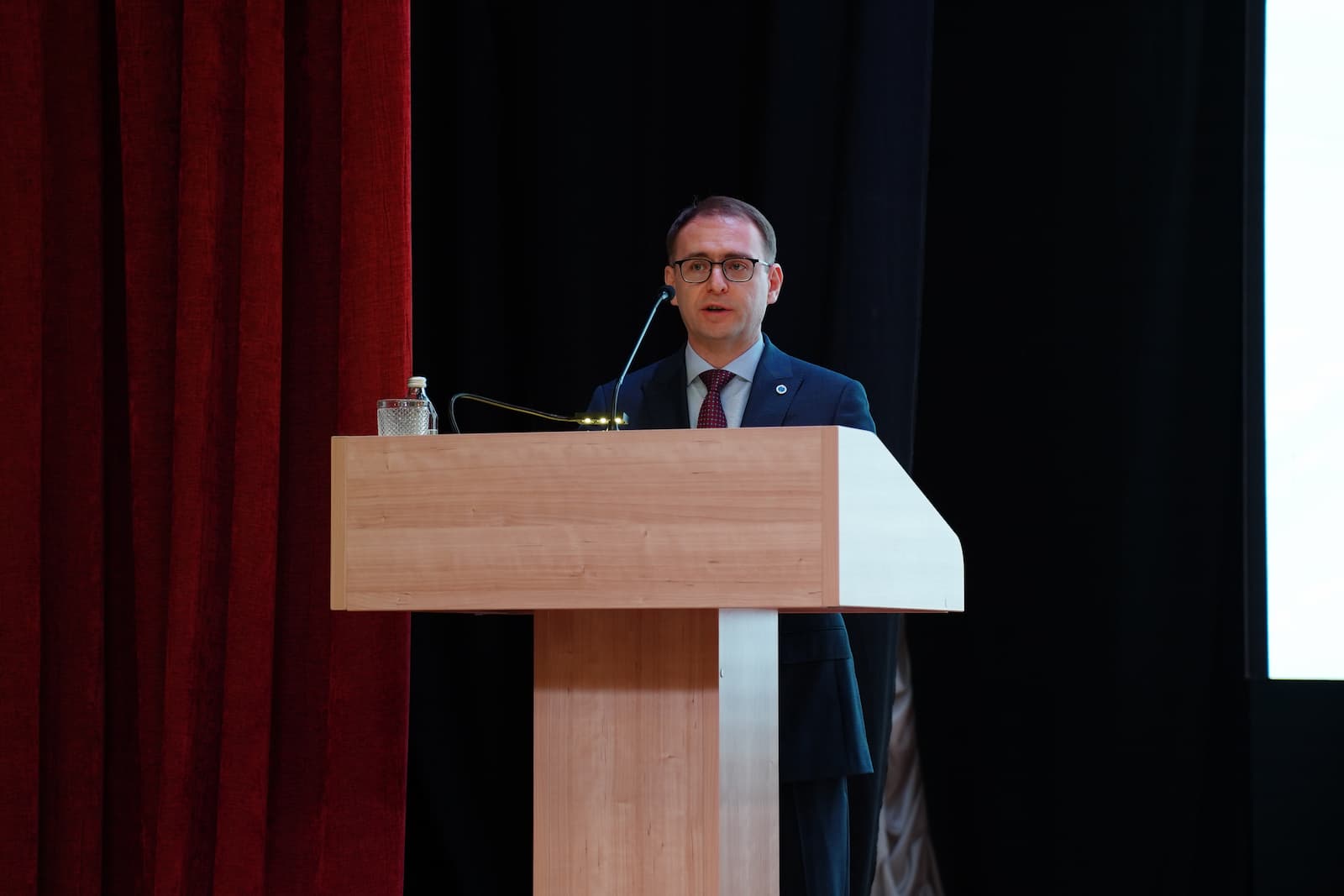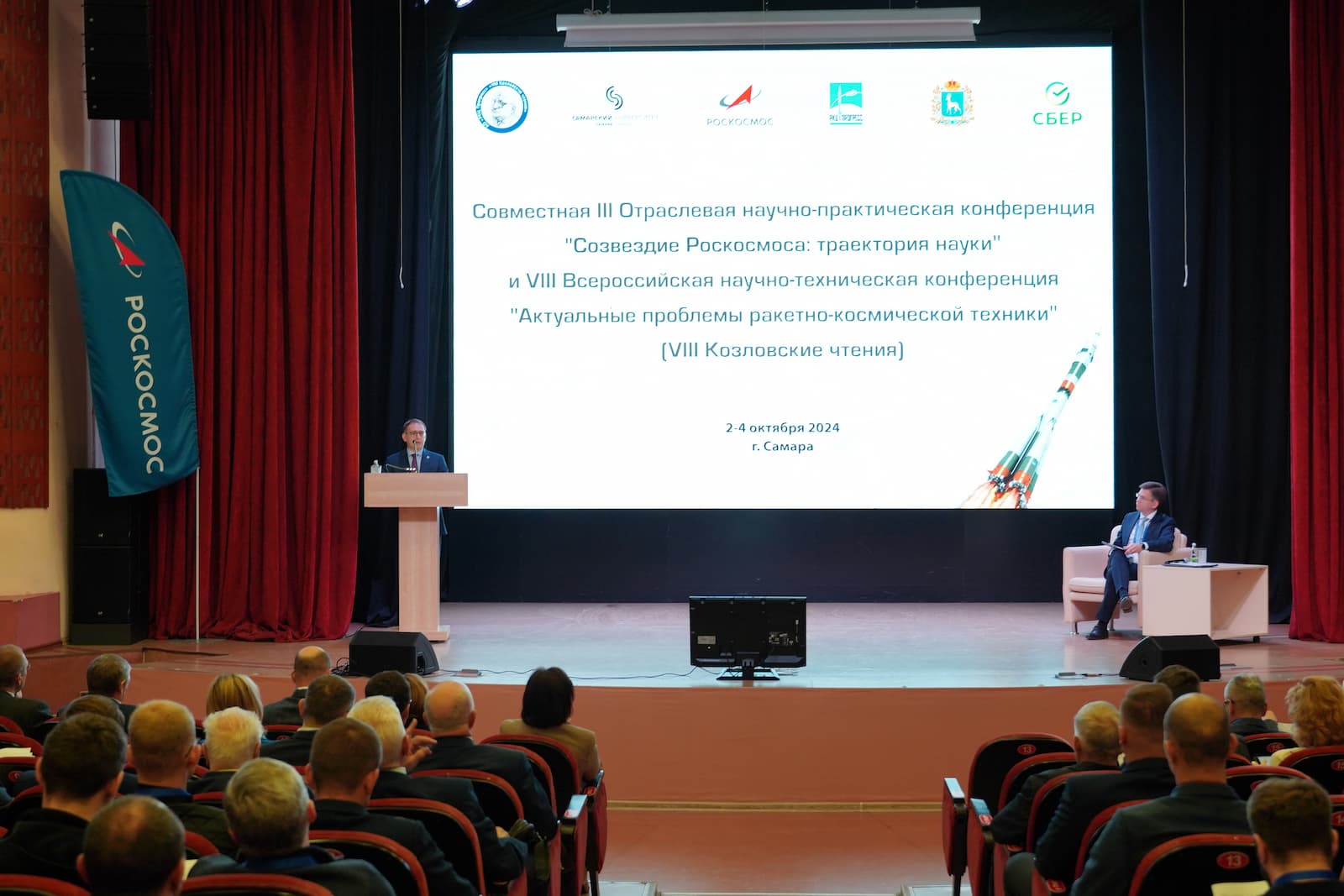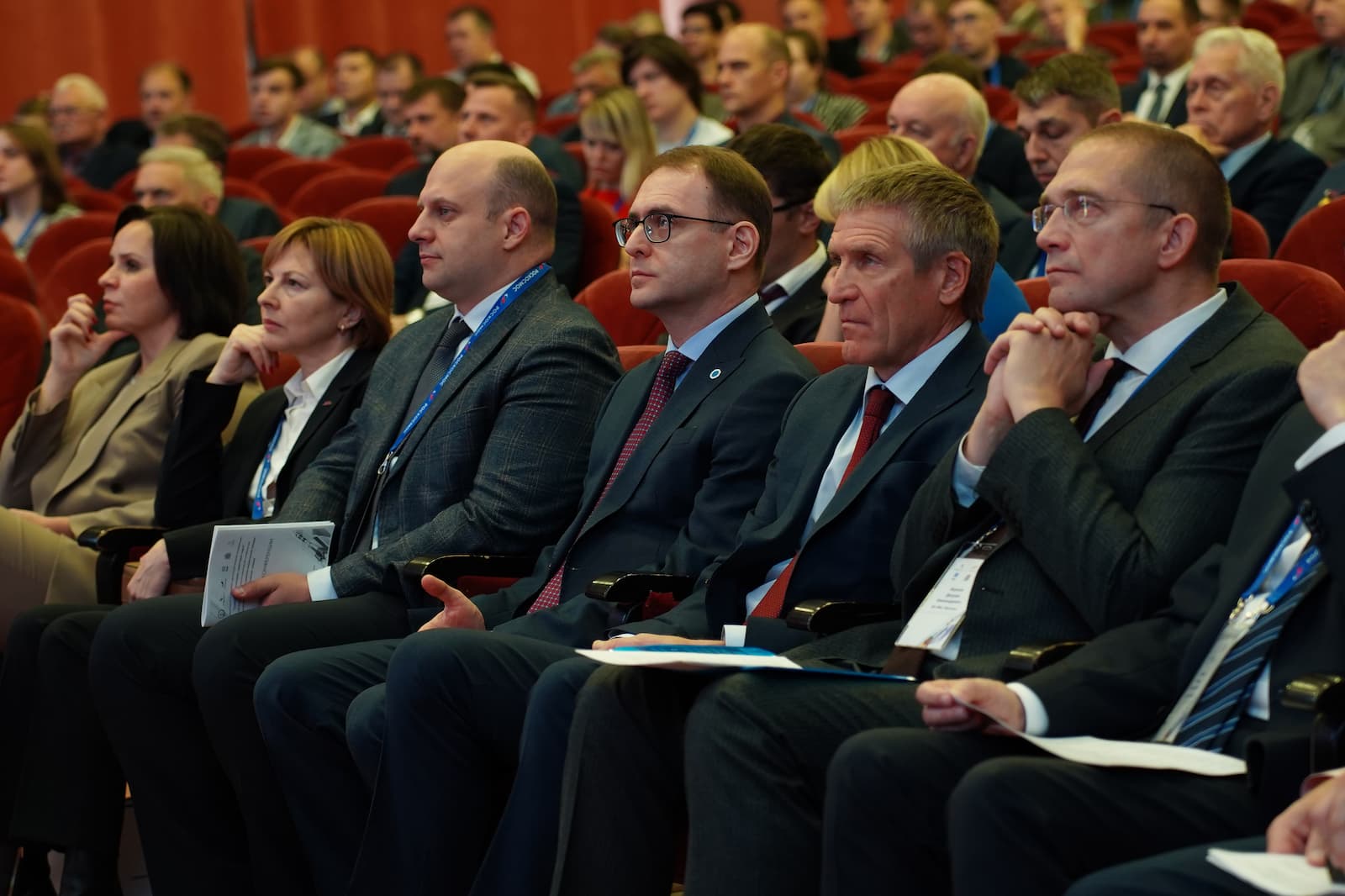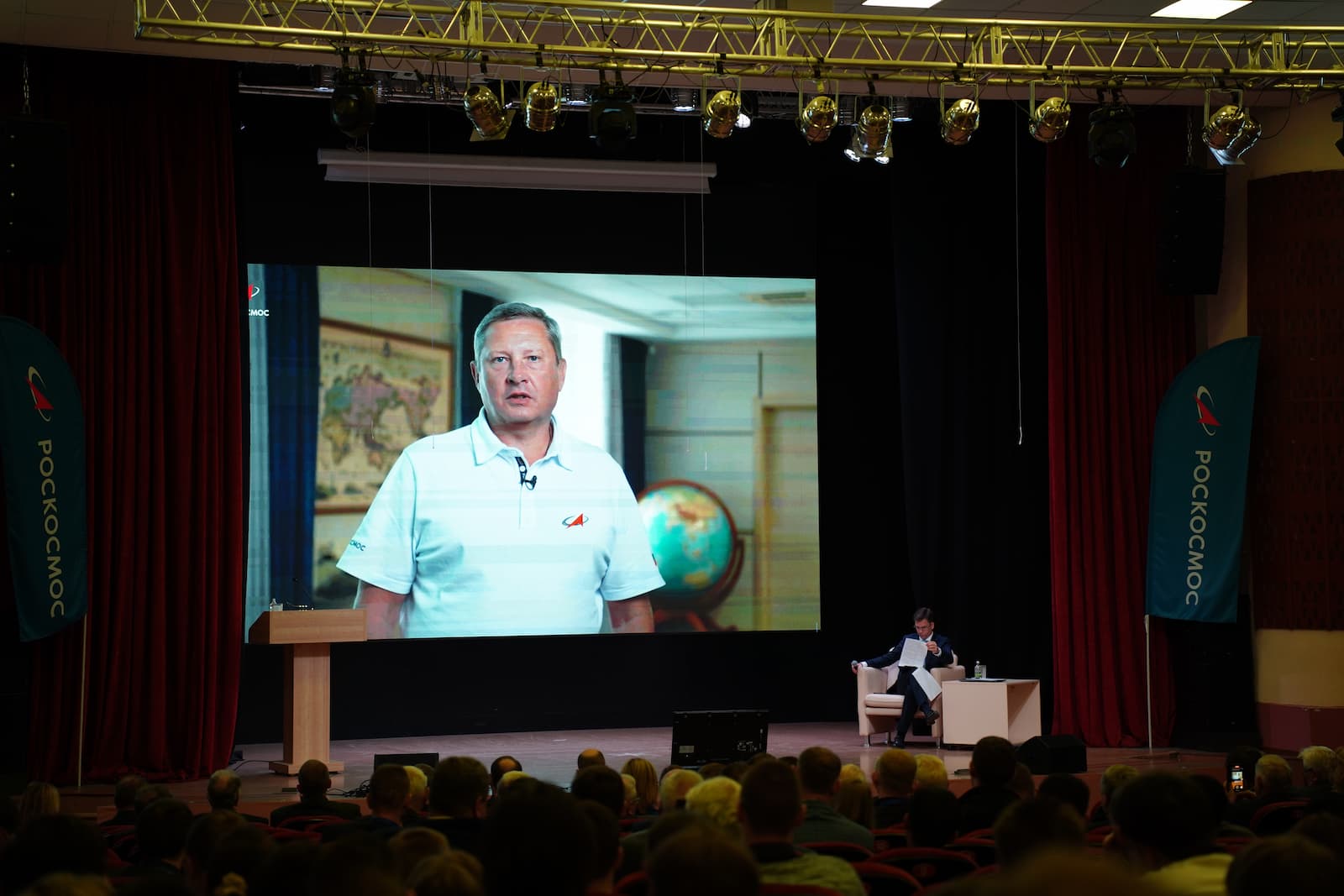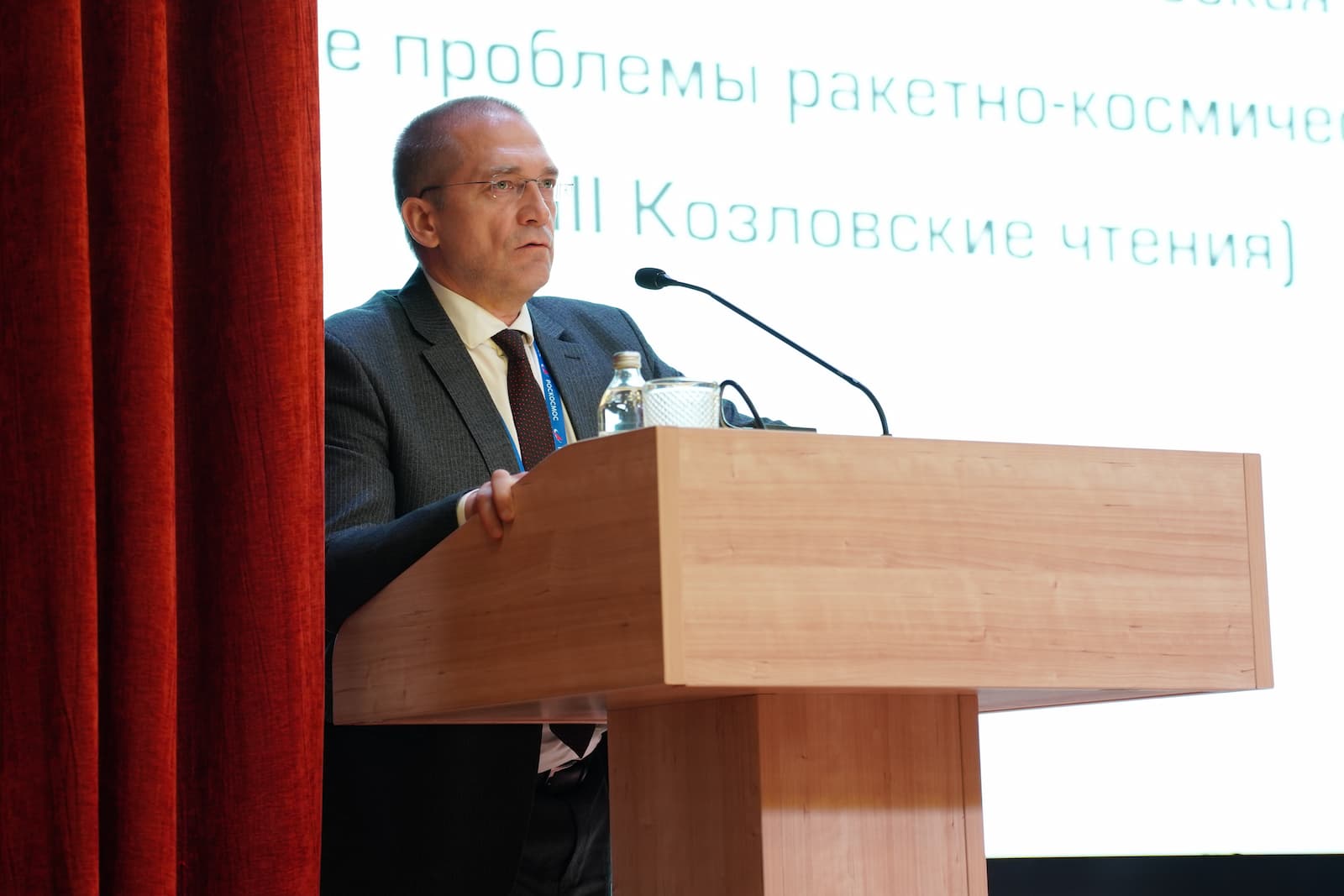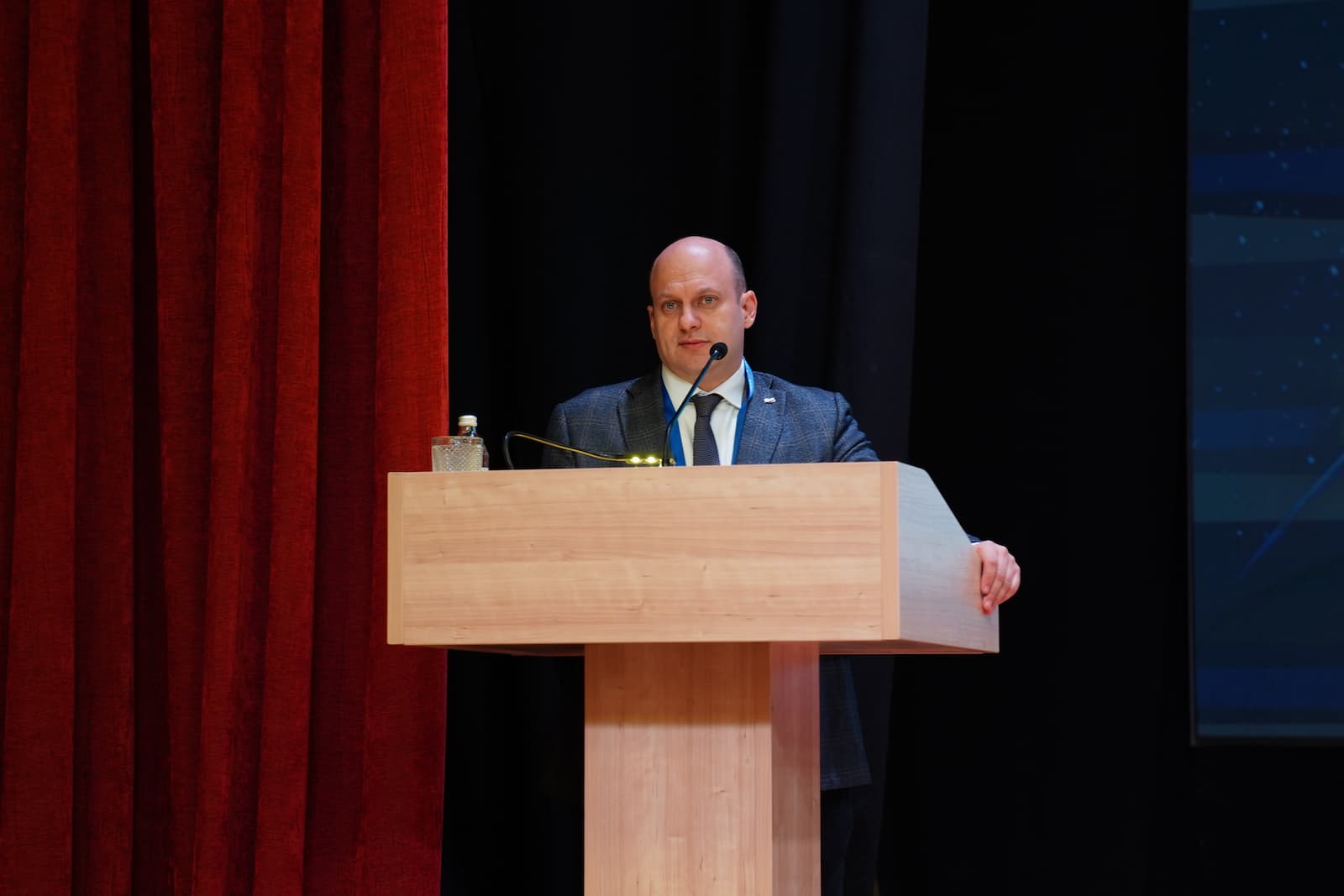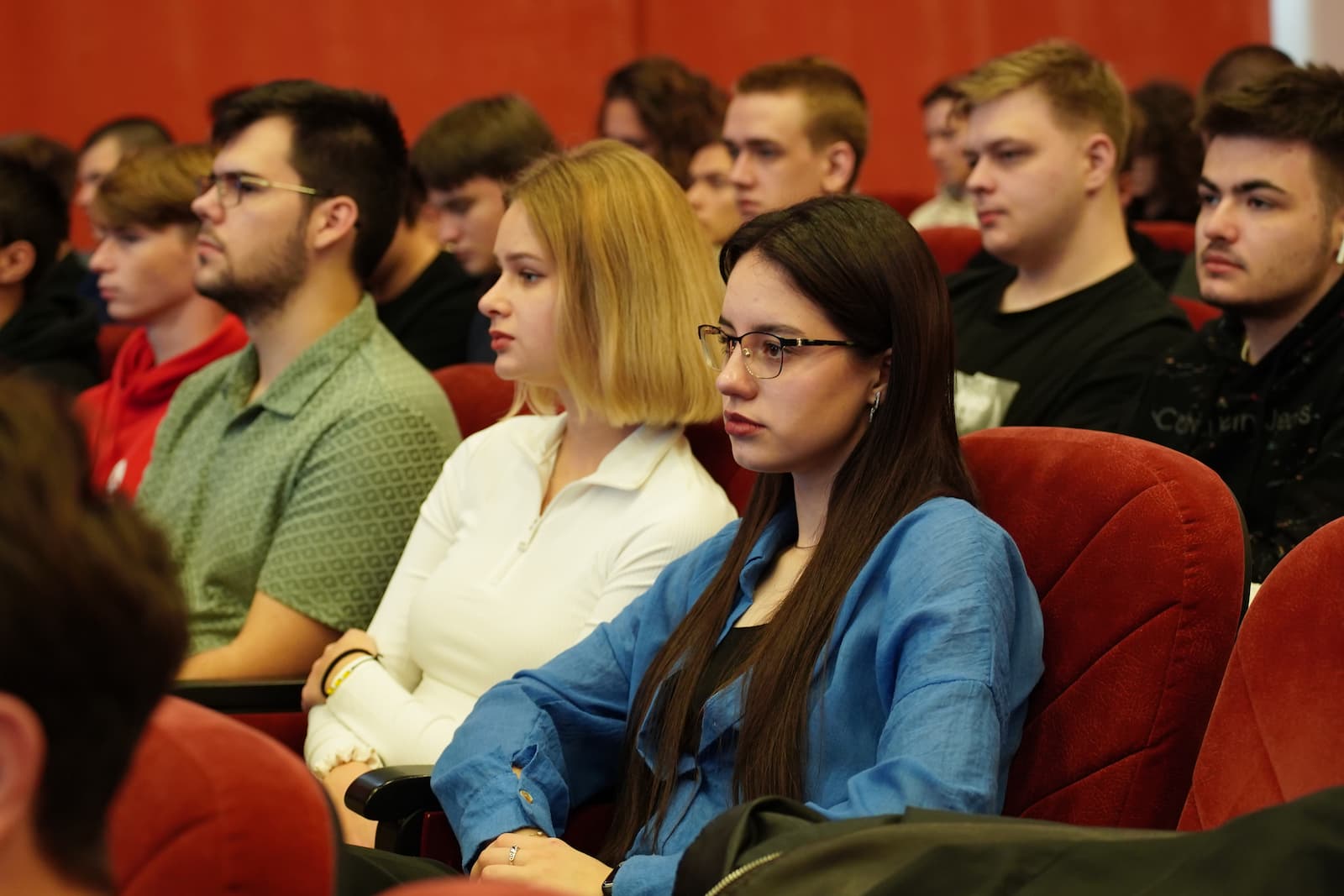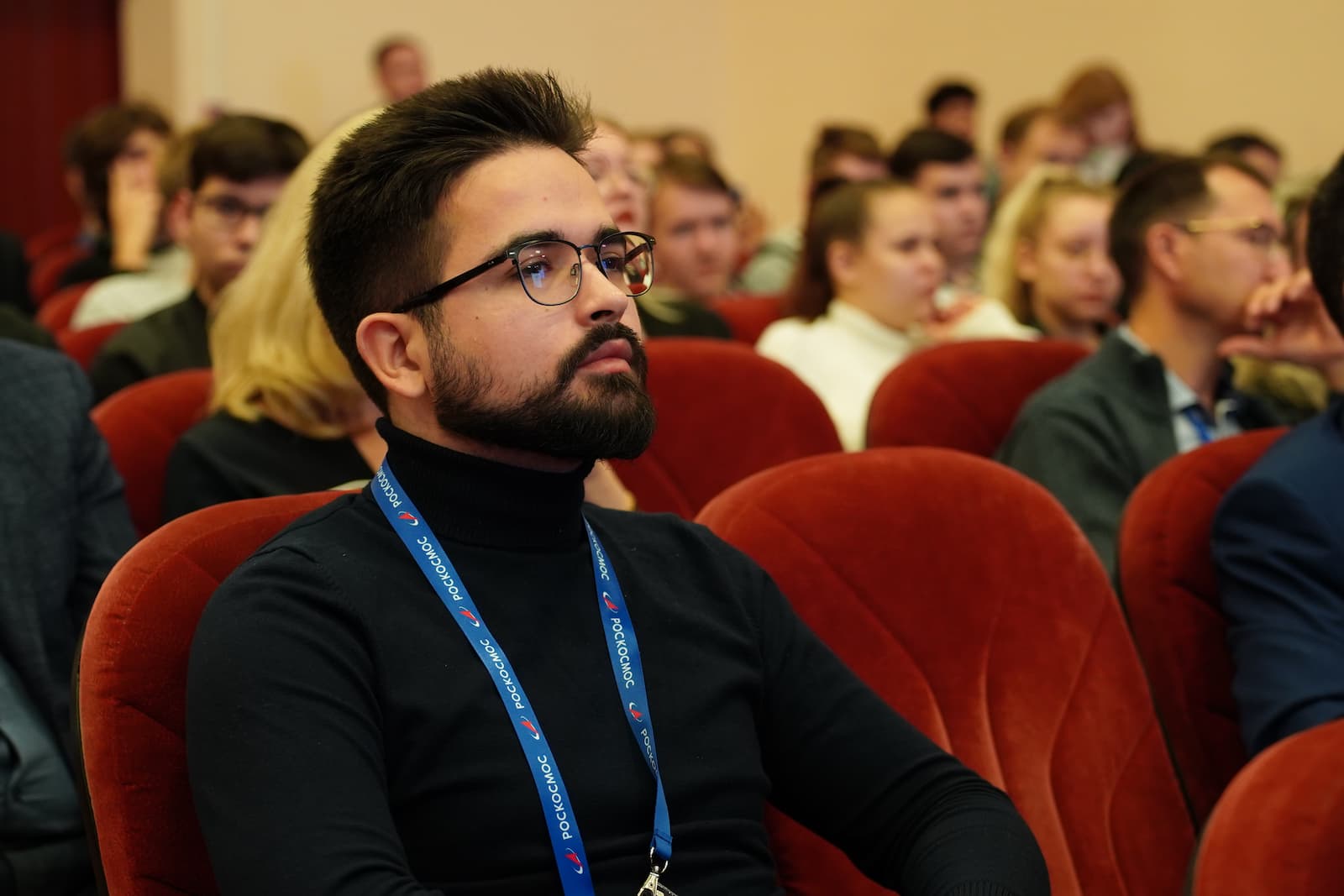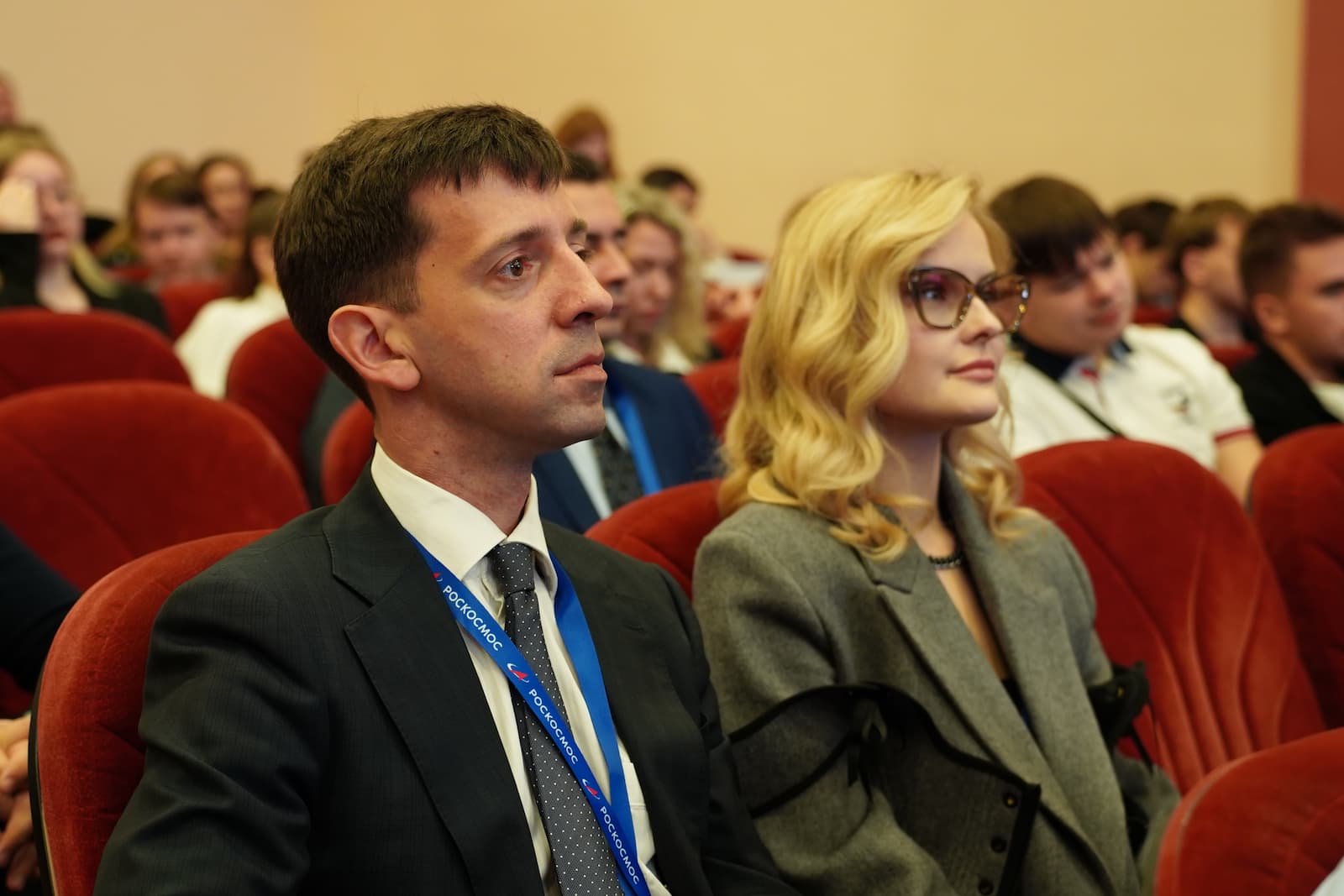On October 2, the 3rd Industry Research and Practice Conference “Constellation of “Roscosmos”: Trajectory of Science” and the 8th All-Russian Scientific and Technical Conference “Actual Issues of Rocket and Space Technology” (the 8th Kozlov Readings) were jointly opened at the venue of Samara University.
The joint Conference is participated by heads and representatives of the “Roscosmos” State Corporation and its leading organizations, specialized universities, research organizations and innovative companies.
Among major objectives of the Conference, there are issues of coordinating activities of the “Roscosmos” State Corporation’s organizations and its main universities, necessary for solving scientific tasks and implementing promising projects for forming the advanced scientific and technical reserve of the rocket and space industry.
The Conference participants were welcomed by Vladimir Bogatyrev, Rector of Samara University. He noted that the Conference is mainly purposed at exchanging experience, best developments in the aerospace industry, and working out solutions on training new engineering personnel in interests of the “Roscosmos” State Corporation.
During the plenary part of the Conference, its participants were addressed by Denis Kravchenko, First Deputy Chairman of the Economic Policy Committee of the State Duma of the Russian Federation. According to him, this format of work is very important for discussing key areas of scientific and technological development of cosmonautics, “Space research and technology are crucially important for ensuring national security, strengthening technological and economic sovereignty and achieving the strategic goals of the state. Samara University is known for its high-level training of the personnel and is one of the most prestigious universities in the country and the world”.
Andrey Elchaninov, First Deputy General Director of the “Roscosmos” State Corporation, also addressed the participants via videoconferencing. He emphasized that development of the space industry is a significant indicator of the state’s development, therefore, “an important condition for activity is dynamism and productivity”. “We must use all the capacities offered by the collaboration of the industry enterprises, universities and scientific organizations given their scientific potential. An example of this collaboration is, among other things, creation of small spacecrafts”, noted Andrey Elchaninov.
Dmitry Shishkin, Director of the Administrative Department of the “Roscosmos” State Corporation, mentioned the need for being in contact with the universities that support the industry, ““Roscosmos”, together with the universities, solves joint tasks in the areas, such as science and personnel training. Our main objective is maintaining and preserving the workforce potential of the rocket and space industry”.
Cosmonauts of the “Roscosmos” State Corporation Aleksey Ovchinin and Ivan Vagner greeted participants of the meeting from the ISS, “We spend many months in orbit, conduct scientific experiments, make space walks thanks to you – brilliant scientists, people who are in love with space. On the Earth, you solve issues of developing Russian cosmonautics, which makes it possible for us to feel confident being off the planet. Due to these conferences, new discoveries are made and the industry develops”.
Viktor Khartov, General Designer of space systems and complexes, Deputy General Director of TsNIIMash, made his presentation “Automatic Outer Space: New Tasks, New Solutions”.
He analyzed development of the Soviet and Russian space exploration programs with automatic devices, told about the mistakes and the experience gained in course of implementing the lunar program.
Much attention was paid by Viktor Khartov to formation of modern multi-satellite orbital groupings. Key trends in their development are maximum unification aimed at reducing their cost and improving their quality, transition to unified platforms, and introduction of robotic technologies in manufacturing spacecrafts.
“It is very good that in our country, there are many “growth points” where new solutions are being developed. And this results in creating the competitive field, which is a perfectly necessary condition for any progress”, noted Viktor Khartov.
Dmitry Baranov, General Director of “Progress” Rocket-Space Centre JSC, named the current trends in the space industry, told about issues to be worked out by his company, as well as the plans for future.
According to the General Director of “Progress” Rocket-Space Centre JSC, dynamic tests of the first stage of the “Soyuz-5” launch vehicle have been completed, the next phase is fire tests. The second stage of the rocket to be also designed for ground tests is in production. Dmitry Baranov spoke about new technical solutions, technological processes and materials used at “Soyuz-5”.
Touching the issue of the Earth remote sensing, he said that the “Resurs-P” No. 5 remote sensing device and the “Obzor-R” radar that are currently in production have reached the final stage of their tests. According to the General Director of “Progress” Rocket-Space Centre JSC, these devices should go into orbit “in the coming months”.
The Conference participants were interested in the information on applying artificial intelligence technologies in remote sensing spacecrafts and ground infrastructure.
Dmitry Baranov finished his presentation with the information on developing the “Amur-LNG” launch vehicle with its reusable first stage. Its technical design is currently underway, the estimated mass of the payload launched into a low reference orbit in the reusable version is at least 10 metric tons, in the disposable version – at least 12 metric tons. According to the forecast made by the head of “Progress’ Rocket-Space Centre JSC, the “Amur-LNG” will soon completely replace the “Soyuz-2” rockets.
Rector Vladimir Bogatyrev’s speech was dedicated to cooperation with the “Roscosmos” State Corporation. He spoke about the projects implemented in interests of this State Corporation. For example, Samara University developed and manufactured several sets of equipment for the “BION-M” No. 2 Research Satellite, the unit for refueling electric rocket propulsion systems with xenon, and a number of others.
The University participates in large-scale federal projects and programs, where its key industrial partners are the “Roscosmos” State Corporation and its subsidiary – “Progress” Rocket-Space Centre JSC. These are “Priority 2030” and “Advanced Engineering Schools”. Vladimir Bogatyrev paid special attention to the Advanced Aerospace Engineering School (AAES).
“In fact, this is an experiment in transformation of engineering education. One of its features is that the university involves industrial partners in making management decisions on student recruitment, personnel employment, selection of research themes and the content of educational programs through participating in the Council of the Advanced Aerospace Engineering School”, explained the Rector.
He focused attention on the fact that the Conference program provides for visiting by its participants new educational spaces of the AAES. Vladimir Bogatyrev also spoke about the University’s initiative projects for development of small spacecrafts, about operation of the Commercial Space Centre created on behalf of the “Roscosmos” State Corporation, as well as about competitions for students and schoolchildren, organized by the Center for Experiments in Outer Space.
“Together with the State Corporation, we are currently preparing four most interesting scientific experiments for the International Space Station (ISS), selected from those proposed by winners of the competition. We hope to be able to conduct them”, resumed Vladimir Bogatyrev.
Oleg Orlov, Director of the Institute of Biomedical Problems of the Russian Academy of Sciences (RAS), noted that today, in the Russian segment of the ISS, the largest amount of experiments is in the field of biomedicine. These studies are aimed at the future and are related to the prospect of developing and launching the Russian Orbital Service Station (ROSS).
He focused on the upcoming launch of the “BION-M” No. 2 Research Satellite in March 2025, which has no analogue in the world of cosmonautics. Oleg Orlov linked the planned biological experiments on board with the upcoming exploration of polar orbits by Russian manned cosmonautics, in particular with the process of designing and deploying the new orbital complex, in which a biomedical module must be provided for.
“We must think over and prepare experiments for the ROSS right now”, expressed Oleg Orlov his confidence. “We also really need breakthrough space technologies, such as artificial gravity”, said the Director of the Institute of Biomedical Problems of the Russian Academy of Sciences.
Anatoly Petrukovich, Director of the RAS Space Research Institute, dedicated his report to challenges and prospects of current near-Earth space research. He spoke about a completely unexpected surge in solar activity, which does not fit into the generally accepted models of the Sun’s behavior and now significantly affects the space environment at altitudes where the ISS orbit is. The station is experiencing increased resistance and loses up to 100 meters of altitude per day.
Anatoly Petrukovich also spoke about ionospheric research, which, in particular, involves cubesats developed and manufactured at Samara University.
The Plenary Session ended with the thematic presentation “Dmitry Ilyich Kozlov: Mentor and Teacher. To the 105th Anniversary of His Birth” made by Ravil Akhmetov, Deputy General Director and General Designer of “Progress” Rocket-Space Centre JSC.
Having finished its Plenary Session, the Conference continued working in the form of nine Sections and the Round Table. On October 3, the participants will gather in the territory of “Progress” Rocket-Space Centre JSC, and the event will end on Friday, October 4.
For reference:
The Conference is organized by the “Roscosmos” State Corporation, “Progress” Rocket-Space Centre JSC, Samara National Research University, Sber, the Government of the Samara Region, and ANO “Roscosmos Media”.
The Conference Sections:
· Designing and manufacturing automatic spacecrafts and space systems.
Ground-based space infrastructure.
· Control systems, space navigation and communications.
· Promising means of launching. The Russian orbital station.
· Engines, power facilities and service systems of automatic spacecrafts.
· Advanced production technologies for spacecraft mass production. Intelligent robotic systems and space complexes.
· Advanced materials, structures and technologies, as well as tests, for rocket and space engineering.
· The unified digital environment for designing and manufacturing rocket and space engineering. Mathematical methods of modeling, controlling and optimizing.
· Constellations of small spacecrafts as promising technological and scientific missions. Small spacecrafts in ultra-low and lunar orbits. Small spacecrafts and deep outer space.
· Improving competitiveness of the rocket and space industry organizations in the labour market: issues of attracting young specialists, talented youth, developing managers’ capacities. Economic issues of the aerospace industry.
The Conference will also include the Round Table “Creating the Advanced Scientific and Technical Reserve in Organizations of the “Roscosmos” State Corporation”. Models and mechanisms of collaboration covering enterprises, universities, research organizations and innovative companies”.
Photo: Olesya Orina
 RU
RU  EN
EN  CN
CN  ES
ES 